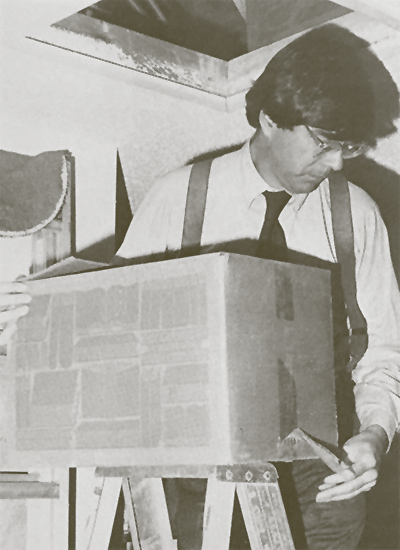It's not often, and might even be unprecedented, that a two-man law firm would agree to represent a freelance inventor in a suit against the largest corporation in the world. But that's what occurred in 1979 when attorney Ted D. Lee agreed to represent me in a breach of contract action against Bell Telephone Laboratories, the research arm of AT&T. Ted was well informed about the size of AT&T when I first met him to seek advice about how best to respond to Bell Labs' claim that they had invented a technology I had submitted to them in 1973. 20,000 of AT&T's employees worked at Bell Labs, many of them world class scientists and engineers, seven of whom had received Nobel Prizes. The Vice President and General Counsel of Bell Labs was renowned patent attorney William L. Keefauver, who administered a legacy of some 20,000 patents and headed a staff of nearly 100 patent attorneys together with a support staff of several hundred.

Western Electric attorney Patrick Leach removing box of documents from Mim's attic. (Forrest Mims)
My invention was a novel method for transmitting voice and computer data in both directions through a single optical fiber by employing a light-emitting diode (LED) at each end of the fiber. The key to the invention was my 1972 discovery that LEDs can both emit and detect light. When I sent an invention disclosure to Bell Labs, Mr. Keefauver replied that "…we will consider your idea of suggestion" if I agreed to the Bell Labs invention suggestion policy, and two months later Keefauver wrote that the invention: "does not contain any novel features of sufficient interest to us at the present time to warrant acquiring rights thereunder." The "present time" clause must have expired in November 1978, for that's when several magazines announced that Bell Labs had developed a new kind of telephone that incorporated the invention I sent them.
Ted listened carefully and asked pointed questions as I recited these facts and showed him my notebook and correspondence. I was optimistic he would agree to take the case when I noticed two books I had written on the bookshelf behind him, one of which had disclosed the invention I sent Bell Labs.
Even though the statute of limitations was fast approaching, Ted and his partner Mark Miller agreed to take on Bell Labs, and soon filed suit against them on my behalf in the Federal District Court of San Antonio. There followed depositions in New York, where I watched as Ted, a former Marine Corps captain, expertly questioned a series of scientists and a Bell Labs patent attorney about the case. Each time the team of Bell Labs and Western Electric attorneys aggressively objected to Ted's questions, he calmly proceeded until he got the response he wanted.
Bell Labs eventually hired Richard Keeton, a prominent Texas business attorney, to represent them. After Keeton deposed me for nearly four days, the tone of his questions seemed to indicate he was having doubts about Bell Labs' position. At the end of the last day, the Bell Labs and Western Electric attorneys were preparing to leave when Keeton asked, "What are you turkeys going to do?" The ordinarily aggressive attorneys looked stunned as they explained they were heading for the airport. After they left, Keeton asked a few more questions. He then leaned back in his chair, propped his cowboy boots on Ted's table and said it would be best for both sides to settle the lawsuit. Ted then leaned back in his chair, placed his cowboy boots on the same table and quickly worked out a friendly agreement with Keeton.
Read more of the story from the book Siliconnections.
